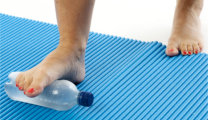 My name is Natalie March from Physio-logical.
My name is Natalie March from Physio-logical.
We hope you found our exercises for neck pain in our last article useful.
We have had lots of patients suffering from Plantar Fasciitis due to home working and walking around in bare feet all day, who have taken up running, or are exercising more than normal.
Today’s subject is Plantar Fasciitis, I’ve had it for ages, what can I do to help?”
What is Plantar Fasciitis?
Plantar Fasciitis is the third most common injury in runners and approximately 10% of people have Plantar Fasciitis at some point during their lifetime. It is a pain in the heel and underside of the foot.
The plantarfascia itself is a tough band of fibrous tissue that extends from the heel bone to the toes. It supports the arch of your foot and takes a lot of load during walking and running. Plantar Fasciitis is an overuse injury to the fascial sheet on the sole of the foot.
Cause of Plantar Fasciitis
- When there is an increased load placed on the plantarfascia by running, walking, playing tennis or by a patient’s biomechanics.
- Tight calf muscles
- Poor footwear
- Poor glutes control
- Calf muscle weakness
What are the symptoms of Plantar Fasciitis?
People with Plantar Fasciitis may have a number of symptoms including:
- Pain on the bottom of your foot, sometimes going into your heel.
- Usually the first few steps in the morning are painful but this gradually settles as you continue walking.
- Walking barefoot, on your toes, going up stairs and running all tend to aggravate the pain.
Treatment
There are lots of different treatment options from taping, to sports massage to release of tight calf muscles and Plantar Fasciitis ankle joint mobilisation, strengthening exercises, stretches, acupuncture and ultrasound.
Plantar Fascia Stretch
- Hold the stretch for 10 seconds, repeat 10 times, at least 3 x day
- Do this exercise before taking your first step in the morning, and before standing after prolonged sitting
Frozen Can or Water Bottle Roll
 Roll your bare injured foot back and forth from your heel to your mind-arch over a frozen can or bottle.
Roll your bare injured foot back and forth from your heel to your mind-arch over a frozen can or bottle.- Repeat for 3-5 minutes. This exercise is particular helpful if done first thing in the morning or at the end of the day
Heel Raise
- Every second day for three months.
- Every heel-rise consisted of a three second concentric phase (going up) and a three second eccentric phase (coming down) with a 2 second isometric phase (pause at the top of the exercise).
- The high-load strength training was slowly progressed throughout the trial as previously reported by Kongsgaard et al.
- 12 repetition maximum (RM) for three sets.
- After two weeks, they increased the load by using a backpack with books and reduced the number of repetitions to 10RM, simultaneously increasing the number of sets to four.
- After four weeks, they were instructed to perform 8RM and perform five sets.
- They were instructed to keep adding books to the backpack as they became stronger.
- A key clinical point is that the calf-raises need to be done slowly.
If any of the above sounds familiar or if you suffer from Plantar Fasciitis then we can help you here at Physio-logical in Stansted Park, Rowlands Castle and Horndean. We all regularly see clients with a wide range of foot and heel pain symptoms.
Call our clinic today on 07835 712306 to find out more about how our team of experienced Physiotherapists, sports therapists and soft tissue therapist can help. Alternatively you can get in contact with us via: enquiries@physio-logical.net